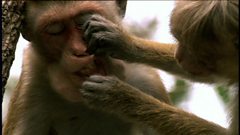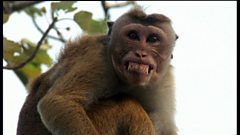
Bat cave
In the toxic air of a bat cave, opportunists blunder into a seasonal bonanza.
Darkness is not a problem for bats who navigate by echolocation, but for any other animals living in the caves getting around presents a serious challenge. The droppings produced by the vast assemblage of bats poses another major obstacle. It creates an atmosphere thick with ammonia and fungal spores that can be fatal for those that inhale them. The guano accumulating on the cave's floor sustains a living carpet of flesh-eating beetles and their larvae that make short work or anything they can get hold of. This is about as hostile an environment as you're likely to find, but this doesn't deter unfussy opportunists. Skunks seem almost at home here. But what tempts them into this repellent place? The answer is baby bats. Unable to fly, many lose their footholds and fall. They can survive the skunks who can't see in the dark, if only they can get back up the cave wall. So many fall, that the skunks are likely to blunder across enough to make the visit worthwhile. To avoid being bitten the skunks roll the bat on the ground to subdue it. Raccoons too venture into the caves for the seasonal offering - it seems to be just the place for an opportunist that can see with its hands. No one knows exactly which sense these predators use to find their prey here. Smell seems unlikely in the toxic atmosphere. And how could a skunk or raccoon hear the distress calls of a baby bat amongst the squeaks of millions of others? The most likely answer is that they use a combination of touch and luck. They rely on bumping into the bats.
Duration:
This clip is from
Featured in...
![]()
成人快手 Nature
Be captivated, informed and inspired by the world's wildlife.
More clips from The Life of Mammals
-
![]()
Sentry Duty—Life in the Trees
Duration: 01:52
-
![]()
Pecking order—Social Climbers
Duration: 02:16
-
![]()
Sneaky mating—Social Climbers
Duration: 03:31
-
![]()
Giant rodents—Chisellers
Duration: 03:55






